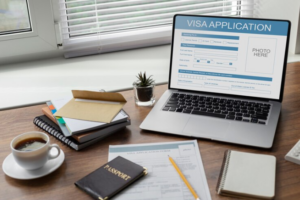Understanding the Different Types of Work Visas in the USA

It can be difficult to negotiate the U.S. immigration system to work here. Legal employment requires a knowledge of the different kinds of work visas, qualifications, and criteria. This guide addresses all you need to know—including the differences between a work visa and a work permit, the expenses involved, and the required application procedures.
What is a Work Visa vs. a Work Permit?
Many people are confused by the differences between a work permit and a work visa. In simple language:
- Work Visa: This document is designed to let non-citizens enter the US for employment. This paperwork is acquired before you enter the United States and is usually specific to a job or company.
- Work Permission: Often referred to as an Employment Authorization Document (EAD), this is not a visa. It allows people to work in the United States but does not function as an entrance document. For instance, some temporary visas, such as the F-1 student visa, call for a work permit for specific employment types.
Types of Work Visas in the USA
Depending on the type of work, duration of employment, and eligibility, the United States grants several work visas. The following is a summary of the main varieties of U.S. work visas together with their requirements:
-
H-1B Visa: For Fields of Specialty Employment
Among the most often used kind of work visas available in the United States are the H-1B ones. It is for experts in specialized fields usually needing a bachelor’s degree or above. These cover fields like engineering, healthcare, and IT.
- Duration: Up to three years, then extending to six years.
- Cost: The federal filing fee is about $460; the company pays most of the other expenses; but additional fees could run thousands more.
- Eligibility: Requires an employment offer in a related field.
-
L-1 Visa for Intra-companies Transfers

Employees of multinational corporations being sent to the U.S. branch in a managerial, executive, or specialist knowledge capacity are eligible for the L-1 visa.
- Duration: L-1A (managers) can run up to seven years; L-1B (specialist expertise) runs up to five years.
- Cost: Government fees run about $460; the company could add further legal fees.
- Eligibility: Must have worked for the company overseas for at least one year.
-
O-1 Visa: For Those Possessed with Extraordinary Ability
Those with exceptional artistic, scientific, educational, business, or athletic abilities or accomplishments are eligible for the O-1 visa.
- Duration: Originally three years, with extensions allowed in certain circumstances.
- Cost: Usually about $460, filing fees vary; premium processing increases this amount.
- Eligibility: Needs documented proof of exceptional talent, such as published works or awards.
-
E-2 Visa: For Businessmen and Investors
Those who significantly invest in a U.S.-based company qualify for the E-2 visa. Only nationals of treaty countries can access it.
- Duration: Usually awarded for two years, renewable indefinitely as long as the business remains operational.
- Cost: Investing level and nationality determine fees.
- Eligibility: Calls for a large investment in a U.S. company.
-
TN Visa: For Mexicans and Canadian Professionals
Under NAFTA (USMCA), the TN visa is particular to professionals from Canada and Mexico. It addresses careers like accounting, engineering, and law.
- Duration: Usually up to three years but renewable indefinitely.
- Cost: Application fee differs nationally.
- Eligibility: Demands evidence of qualifications and a job offer in a related field.
Temporary vs. Permanent Work Visas
- Temporary Work Visas: Temporary work visas (H-1B, L-1, O-1) have a designated duration and are designed for non-permanent employment.
- Permanent Work Visas (Green Card): These call for a labor certification and employer sponsorship and let individuals engage in long-term employment and residence in the United States.
Applying for a Work Visa: Step-by-Step Guide

-
Determine the Right Visa Type
Determine the appropriate visa type using the job offer, educational background, and credentials. Between visas, the requirements, processing times, and expenses differ greatly.
-
Arrange Documents
- Job offer letter
- Degree certificates and transcripts
- Passport and recent photos
- Documentation proving eligibility (e.g., work experience, specialized skills)
-
Employer Application (If Needed)
Like the H-1B, many work permits call for the employer to submit a petition to U.S. Citizenship and Immigration Services (USCIS). The employer might have to apply for labor certification with the Department of Labor (DOL). This process ensures that hiring a foreign worker does not negatively impact the U.S. labor market.
-
Submit the Application
Once the employer has completed the required documentation, the applicant can apply from their home country at a U.S. Embassy or Consulate. It is essential to ensure that all forms are correctly filled out and submitted on time to avoid delays.
-
Attend a Visa Interview
Most candidates will have to show their paperwork and respond to inquiries regarding their employment and background at an interview conducted at a U.S. Embassy or Consulate. Being well-prepared for this interview can significantly enhance the chances of a successful outcome.
Who Pays for a Work Visa and How Much Does It Cost?
Depending on the type of visa, legal expenses, and whether premium processing is chosen, U.S. work visas cost very differently. Here’s a broad view of the expenses involved:
- H-1B Visa Costs: The filing price is roughly $460; additional payments for the employer include the ACWIA price ($4,000) and the Fraud Prevention and Detection Fee ($500).
- L-1 Visa Costs: Starting fees are about $460. If necessary, premium processing fees can rise to $1,225.
- O-1 Visa Costs: Filing fees start at $460; however, extra fees may apply if the visa calls for urgent processing.
- E-2 Visa Costs: This varies based on the treaty countries but usually includes the application fee and investment evidence costs.
Who Pays for the Visa?

In many cases, the U.S. company is liable for paying visa expenses, especially for employer-sponsored visas like H-1B and L-1. However, certain visas, such as O-1 and E-2, can require expenses that the applicant must pay for themselves.
Essential Pointers for an Effective Work Visa Application
- Verify Employer Sponsorship: Check your company’s willingness to sponsor the visa if it is necessary.
- Prepare Thoroughly: Review every document twice because mistakes can slow down processing.
- Know the Costs: Visa fees vary; find out whether your company will pay them or whether you have to prepare.
- Seek Legal Help: If possible, consult an immigration attorney to avoid mistakes—especially for specialty visas like O-1 or E-2.
Frequently Asked Questions About U.S. Work Visas
A Work Visa Costs How Much?
The cost of a work visa varies by type and employer. For example, the H-1B visa runs about $460 in filing expenses, but additional fees could be charged, therefore costing more. Many times, companies cover these costs.
How Long is a Working Visa Good For?
Usually valid for up to three years, most work visas include optional extensions. However, the type of visa will affect the length.
What is the “W Visa”?
The W visa is designed to draw highly qualified foreign workers so they may live and work in the United States. However, it is not yet extensively available.
Conclusion
Finding legal and effective employment in the United States depends on an awareness of the various kinds of work visas. Whether your interests are those of an investor, entrepreneur, or professional, there likely is a visa fit for you. Following the guidelines provided and preparing well can help you to raise your chances of a successful application.
Conclusion
Call Passage Immigration Law right now for professional advice on the visa application process if you want to know your best choices for working in the United States. Our staff is here to guide you through each stage of realizing your American dream.
